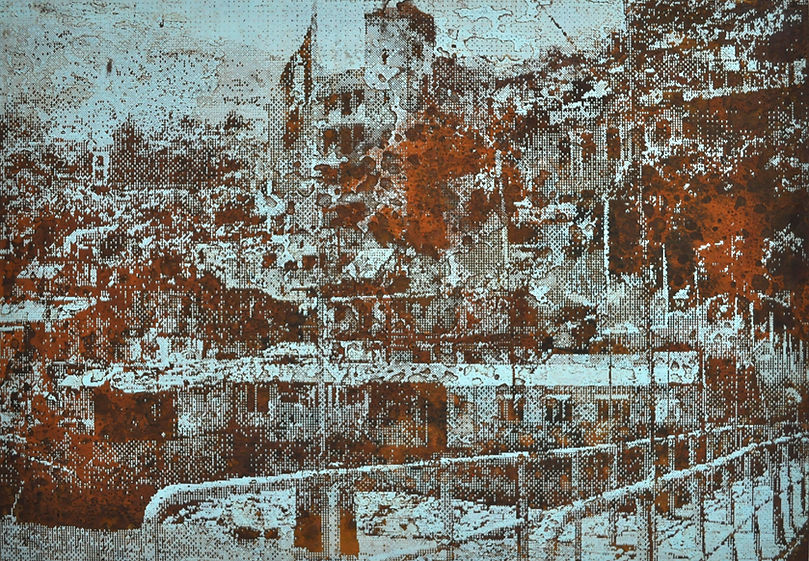The Opposite Survivor: 1950 - 1995
彼岸的遺民:1950 - 1995
2018
Printmaking Archive Installation
Silkscreen printing on black iron- black iron plate; acrylic;
silk banner; SINGER sewing machine; books; Documentary video
Dimension Variable
Silkscreen printing on black iron- black iron plate, acrylic: 14x21, 10 pieces; 29x42, 25 pieces; 42x59, 5pieces;
Video: 23minutes and 22 seconds
版畫檔案裝置
版畫: 孔版黑鐵板本
檔案裝置:
民國67年國慶香港調景嶺回國代表祝賀團錦旗、SINGER衣車、《香港調景嶺營的誕生與消失 : 張寒松等先生訪談錄》、《自由的代價 : 中華民國與香港調景嶺難民營1950-1961》、《調景嶺義民反共奮鬥史實》、《點滴記憶:再會舊社區》、《硝煙歲月:「日落調景嶺」前傳》、《九龍照舊》、《山河.家國.難民情:調景嶺小故事》、調景嶺檔案錄像
依場地而定
版畫:14x21,10件;29x42,25件;42x59,5件
錄像:23分22秒
During the years between 1950 and 1995, there was a community linking Hong Kong and Taiwan. This may not be known by all Taiwanese and Hong Kongers. This is where the flags of the Republic of China were proudly hoisted, where the Three People’s Principles were chanted with glory, where the school syllabus was in accordance with that of Taiwan’s Ministry of Education. The 10th of October would have been the biggest event of the year. This under-reported community, located then in the wilderness, is called “Tiu Keng Leng”.
"Tiu Keng Leng" was a military dependents' village of the Republic of China in Hong Kong, resided by military and government personnel, teachers as well as the educated and the intellectuals. They lived with good character and sophistication. The Chinese Nationalist Party (Kuomintang) once described these people had "rich intellectual assets and an incredible ability to adapt and survive". However, compared with the military dependents’ villages already settled in Taiwan, the villagers in Tiu Keng Leng seemed less fortunate, regarding themselves an abandoned group, stranded in Hong Kong. No government was willing to come to their rescue. Although the Hong Kong government granted them refugee status for short-term stay, the latter did not benefit from any more help due to financial and political issues arising from other refugees. Kuomintang, freshly settled to Taiwan, was unconvinced of the refugees’ real allegiance and dreaded the Communist infiltration, therefore they did not dare to provide assistance. The side of the Chinese Communist Party acknowledged the fundamental conflict in regards to the political consciousness of the remnants of their opponents. Absorbing this community was obviously useless, not to say threatening. Under the struggle of these three conflicting forces, the refugees in Tiu Keng Leng were disillusioned of such slim chance to rejoin Kuomintang’s Taiwan. They resorted to survive on their own. Little by little, a collective life was developed in this strangely unfamiliar habitat.
“The Opposite Survivor: 1950-1995” is an exhibition that sends us back in the old Tiu Keng Leng. Along the timeline stretching these fifty years, we would revisit the habitants’ distinctive social rituals, the religious communities, and experience how the adults struggled with everyday life, how the children enjoyed themselves, how the animals lived wildly and domestically. Life might have been full of hardship in terms of materialistic satisfaction but it was nevertheless spiritually fulfilling. This transient utopian enclave now seems so far behind our times. The exhibition intends to flip the usual perspective adopted from Tiu Keng Leng to Taiwan, as the audience now situate themselves on the Taiwan side overlooking their counterparts in Hong Kong, who strived hard towards an entirely different destination.
或許連現在的台灣人、香港人都不知道,在1950至1995年的差不多半個世紀中,在歷史和命運的偶然底下,曾經出現了一個社區把台灣和香港連在一起,這個社區都掛滿青天白日滿地紅旗,唱著三民主義,社區內的學校課程都跟著中華民國教育部的課綱,以雙十國慶為最大盛事,就是位於香港偏遠荒山的「調景嶺」,又名「吊頸嶺」、「豬乸山」。「調景嶺」就是在香港的中華民國眷村,當中以軍人、政府人員、教師等教育程度高,具有知識水準的人群組成,他們在實際生活各方面都表現出優秀的風度和品格,中國國民黨更稱他們有「豐富的智慧資產和深厚的生命潛力」。然而,與已座落於台灣的眷村相比,這條眷村的村民就沒有那麼幸福,因為他們是一直被遺棄的一群難民,停留在香港這個地方,沒有一個政權願意協助他們,港英政府雖以難民理由讓他們作短期安頓,卻因各方難民所做成的財政、政治危機而不敢予以幫助;剛遷往台灣的國民黨因懷疑他們的身分,擔心當中有共產間諜滲透台灣,都不敢施以援手和開設救濟的先例;而中共方面,對於這群敵方的殘餘勢力,在政治意識上有根本上的衝突,接收他們顯然是毫無利用價值,卻會增添自己的威脅和負擔。在這三方勢力的爭持之下,調景嶺的難民從相信國民黨的救濟,等候國民政府的號召,變成只能靠自己的力量在生存下去,在這個陌生的荒山上,一磚一瓦地建立起家園。本展覽名為《彼岸的遺民:1950-1995》,就是把時空回到當時的狀態,在這近五十年的寒暑中,從調景嶺的情景,獨有的社區習俗,協助和陪伴的教會,成人的掙扎求存,小孩的玩樂片段,社區上生存的動物,都構築著這個艱苦生存卻心靈滿足的歷史記憶。這個曾經出現,自成一國的調景嶺,外人看來就是恍如隔世的烏托邦,本展覽嘗試把調景嶺人仰望台灣的視角反轉,我們站在台灣的眷村中,遠眺彼岸命運殊途的同路人,觀察另一種在異鄉中憑著意志生存的生活經歷。








